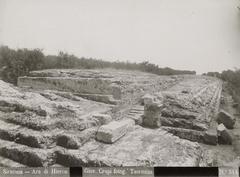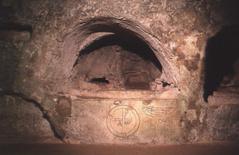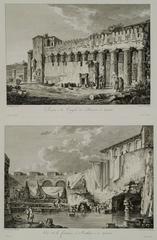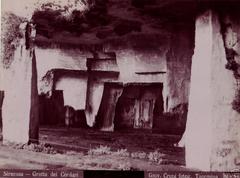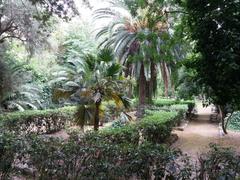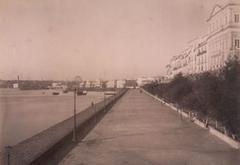
Temple of Athena Syracuse: Visiting Hours, Tickets, and Historical Site Guide
Date: 04/07/2025
Introduction: The Enduring Legacy of the Temple of Athena in Syracuse
Set in the heart of Ortygia, the Temple of Athena in Syracuse stands as a striking testament to the city’s extraordinary past. Originally constructed in the 5th century BCE to celebrate Syracuse’s victory at the Battle of Himera, this iconic structure has endured through eras of Greek, Byzantine, Arab, Norman, and Baroque influence. Today, the ancient Doric temple forms the very core of the Cathedral of Syracuse, creating a unique architectural palimpsest where history, spirituality, and art merge seamlessly (Livius.org; Sicily Visitor).
The temple’s imposing limestone columns, now visible both inside and outside the cathedral, offer a direct, tactile connection to more than 2,500 years of Mediterranean civilization. Through its transformations—from a Greek temple dedicated to Athena, to a Byzantine church, a mosque during Arab rule, a Norman cathedral, and finally a Baroque masterpiece—the site embodies the multicultural heritage and resilience of Syracuse (Once in a Lifetime Journey; Trip101).
This guide brings together essential visitor information, historical context, and practical travel tips to help you make the most of your visit to this UNESCO World Heritage Site (Italia.it; Greek Reporter).
Contents
- Introduction
- Origins and Construction of the Temple of Athena
- Evolution Through the Ages
- Archaeological Discoveries and Architectural Features
- Visiting Hours, Tickets, and Accessibility
- Getting There and Nearby Attractions
- Special Events and Guided Tours
- Frequently Asked Questions (FAQ)
- Visuals and Multimedia
- Practical Visitor Tips
- Conclusion
Origins and Construction of the Temple of Athena
Erected in the 5th century BCE after Syracuse’s triumph at the Battle of Himera, the Temple of Athena marked the city’s rise as a major Mediterranean power (Livius.org). Built in classic Greek Doric style, the temple featured six columns on each short side and fourteen on the long sides, all crafted from local limestone. Archaeological evidence suggests that even older structures lay beneath the temple’s foundations, underscoring the site’s ancient sacred significance.
Evolution Through the Ages: From Pagan Temple to Baroque Cathedral
In the 7th century CE, Bishop Zosimus converted the temple into a Christian church, enclosing the Doric columns within new brickwork walls—an adaptation still visible today (Livius.org). The altar was aligned with the temple’s original cella, preserving its sacred focus.
During Arab occupation in the 9th century, the building briefly served as a mosque, before returning to Christian use under Norman rule in the 11th century. The devastating earthquake of 1693 prompted a Baroque transformation, resulting in the luminous façade designed by Andrea Palma in the 18th century (Once in a Lifetime Journey; Trip101).
Archaeological Features and Artistic Highlights
Visitors to the cathedral can admire:
- Ancient Doric Columns: Integrated into the cathedral walls, these columns are visible both from Minerva Street and inside the nave.
- Byzantine and Norman Elements: Intricate mosaics and marble baptismal fonts reflecting successive cultural layers.
- Baroque Artistry: The façade’s Corinthian columns, statues of saints, and the interplay of light on the white local stone at sunset (Sicily Visitor).
- Museum Artifacts: Original marble tiles and lion-shaped water spouts are preserved at the Paolo Orsi Regional Archaeological Museum (Enjoy Sicilia).
Temple of Athena Visiting Hours, Tickets, and Accessibility
Opening Hours:
- Monday to Saturday: 9:00 AM – 1:00 PM & 3:00 PM – 7:00 PM
- Sunday and Public Holidays: 10:00 AM – 1:00 PM & 3:00 PM – 7:00 PM
- Note: Hours may vary during religious services or holidays. Always check the official cathedral website or local tourism portals before your visit.
Tickets:
- General admission is typically free; guided tours or special exhibitions may require a modest fee (usually €2–€6).
- Tickets for tours or exhibitions can be purchased on-site or online.
Accessibility:
- The cathedral is wheelchair accessible, with ramps at main entrances. Some historic areas have uneven surfaces; assistance is available upon request.
Getting There and Nearby Attractions
Location: Piazza Duomo, Ortygia Island, Syracuse, Sicily, Italy (Italia.it)
- GPS Coordinates: 37.0597°N, 15.2935°E
- By Air: The nearest airport is Catania Fontanarossa, about one hour away.
- By Train/Bus: Direct links from Catania and other Sicilian cities.
- On Foot: The temple is within the pedestrianized center of Ortigia, easily explored on foot (Italia Like a Local).
Nearby Attractions:
- Fountain of Arethusa
- Temple of Apollo
- Paolo Orsi Archaeological Museum
- Castello Maniace
- Local markets and cafés
Special Events and Guided Tours
- Annual Festivities: The cathedral hosts processions for St. Lucia on December 13 and the first Sunday in May (Once in a Lifetime Journey).
- Guided Tours: Available in multiple languages; booking ahead is advised, especially in peak season.
- Virtual Tours: Offered by local tourism offices and official websites.
Frequently Asked Questions (FAQ)
Q: Is the Temple of Athena the same as the Cathedral of Syracuse?
A: Yes; the ancient temple forms the core of the current cathedral, with original columns visible.
Q: What are the entrance fees?
A: General entry is free; tours or special exhibits may require a fee.
Q: What are the visiting hours?
A: Typically 9:00 AM–1:00 PM & 3:00 PM–7:00 PM (Mon–Sat), 10:00 AM–1:00 PM & 3:00 PM–7:00 PM (Sun). Check official sources for updates.
Q: Is the site accessible for people with disabilities?
A: The cathedral provides ramps and is wheelchair accessible in most areas.
Q: Are guided tours available?
A: Yes, in several languages, and highly recommended.
Visuals and Multimedia
- Photos: Seek images highlighting the Doric columns and Baroque façade, with alt text such as “Temple of Athena Doric columns in Syracuse” and “Baroque façade of the Cathedral of Syracuse.”
- Maps: Use interactive maps to pinpoint the temple’s location within Ortygia.
- Virtual Tours: Available on official tourism sites.
- Infographics: Timelines illustrating the temple’s transformations.
Practical Visitor Tips
- Best Time to Visit: Early mornings or late afternoons for fewer crowds and dramatic lighting.
- Dress Code: Modest attire (shoulders and knees covered).
- Photography: Allowed, but avoid flash and tripods during services.
- Respect Services: Maintain quiet during religious ceremonies; the cathedral remains an active place of worship.
Conclusion
Visiting the Temple of Athena in Syracuse is a journey through the city’s layered history—a place where ancient Greek columns rise within a Baroque cathedral, and every stone tells a story of cultural synthesis and resilience. Centrally located in Ortygia and surrounded by historic attractions, the site offers an immersive experience for history enthusiasts, architecture lovers, and all travelers seeking to connect with Sicily’s rich heritage.
Plan ahead by checking current visiting hours, booking a guided tour, and exploring nearby sites to make the most of your time in Syracuse. For updates and travel inspiration, download the Audiala app and follow local tourism channels.
References and Further Information
- Livius.org
- Sicily Visitor
- Greek Reporter
- Italia.it
- Once in a Lifetime Journey
- Trip101
- Enjoy Sicilia
- The World of Sicily
- Italia Like a Local
- Go Ask a Local
- Giovanni Dall’Orto
- Wonderful Italy






